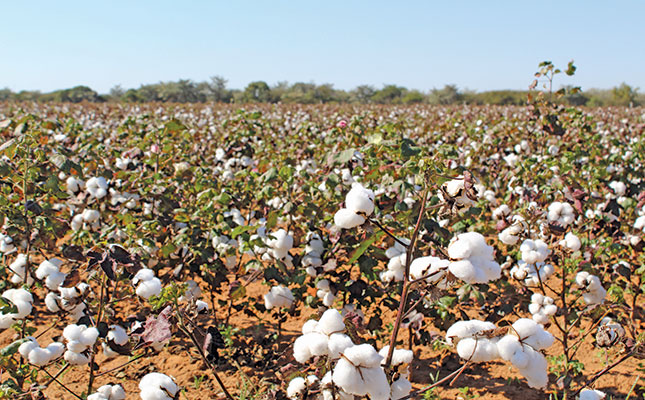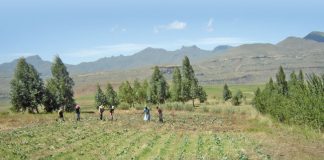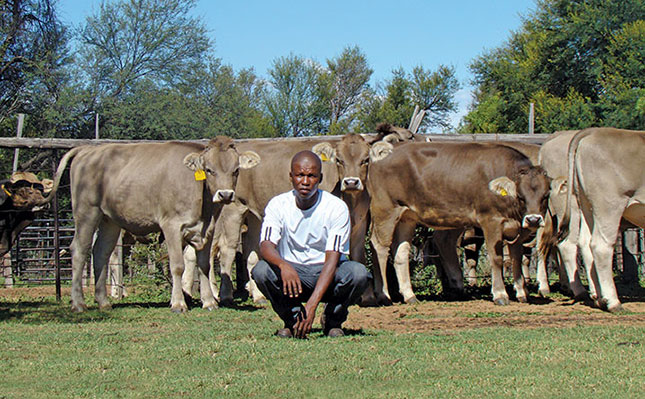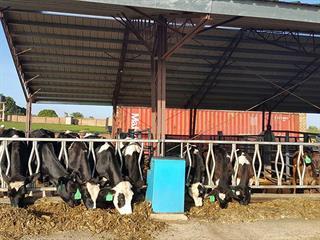
Photo: Lindi Botha
What impact is climate change having on South Africa’s cotton farmers?
Hennie Bruwer (HB): Ironically, we’re currently seeing, and will continue to see, an increase in the number of cotton farmers in South Africa as a result of climate change. This is because cotton can better withstand drier, hotter conditions than other crops grown here.
So while we’re experiencing an increase in heat units and a shifting planting season as a result of climate change, cotton crops are not yet adversely affected.
Water is becoming a bigger issue, as South Africa is a semi-arid country. No new dams have been built since 1994, and our river systems are under pressure. This will also lead us away from thirstier crops to more hectares under cotton, as is already the case. But since cotton still requires water, any reduction in what is necessary to grow a crop will ultimately be detrimental.
Lena Staafgard (LS): Climate change is putting pressure on South Africa’s water supply, leaving farmers to contend with droughts, especially in the Northern Cape. This is particularly challenging for smallholder cotton farmers, who may lack the knowledge and expertise to address these issues. Government funding and support for cotton production could help, but is limited.
Globally, research has shown that all cotton-growing regions will be affected by climate risks, predominantly through heat and water stress, but also through shortened growing seasons. Our focus, therefore, is on helping cotton farmers, especially smallholders, to build climate resilience.
How is this done in practice?
HB: Cotton South Africa (Cotton SA), the implementing partner of the Better Cotton Initiative (BCI) in South Africa, is providing training to BCI farmers across the country, helping them adopt more sustainable practices, such as more efficient irrigation methods and the use of natural pesticides.
We’re also assisting large farms to take full advantage of precision agriculture tools (including satellite data and remote sensing devices), to identify risks, and to optimise farm management, while establishing a formal training programme for smallholder cotton farmers.
Currently, between 60% and 70% of South African cotton farmers have BCI accreditation. This means that most are already implementing systems that make them more resilient and sustainable, and their product more acceptable to consumers.
To qualify, farmers need to fulfil certain criteria on which they’re audited annually. These include implementing policies that protect biodiversity, reduce water usage, improve labour practices, increase soil health and ensure higher yield.
The BCI criteria are actually very well suited to South African farmers, as our labour and environmental laws already ensure that farmers comply. Furthermore, our producers are highly cost-conscious, and using more inputs or water than is necessary isn’t feasible or profitable. We can’t afford to squander our resources, so complying is not overly difficult.
That said, our goal is still to get to 100% BCI certification in South Africa.
Licensing more small-scale farmers remains a challenge where government funding isn’t available. Building smallholders’ capacity and helping them gain access to vital funding and inputs remain important priorities for the BCI.
LS: Building on our experience in developing and funding global programmes to reach cotton farmers at scale, we aim to leverage our convening power and global network to drive change across the cotton sector and beyond.
[Our goal is to] gather stakeholders worldwide to help encourage and grow financial schemes that create incentives for all cotton farmers to adopt more sustainable practices, and to compensate them in the event of climate disasters.
We’re also continually looking at better ways to test, monitor and scale innovative climate-friendly practices. For example, we’re supporting farmers to prioritise soil conservation by using methods such as cover cropping and strip-tillage.
In addition, our partners are working with farmers to use beneficial insects as an alternative to synthetic pesticides, and to employ techniques that use water resources more efficiently, such as short-furrow irrigation, where water flows faster and is distributed more evenly. Combined, practices of this kind can help with both climate change adaptation and mitigation.
The Better Cotton Standard system has always had a strong focus on soil health, but as we move forward, we’ll look to further promote principles of regenerative agriculture that enhance soil health by restoring organic carbon in the soil. Farming practices can play an important role in the soil’s ability to sequester carbon and provide the potential for it to become a carbon sink.
Cotton cultivation has a reputation for being harmful to the environment. What is its impact?
HB: The detrimental impact of cotton on the climate has been greatly exaggerated. The common narrative is that cotton is drenched in chemicals and uses all the water resources in a region. In fact, 55% of the world’s cotton is dryland only, and that which is under irrigation uses only 230mm per year [on average].
Furthermore, since the introduction of genetically modified (GM) cotton, crop-protection chemical applications have been reduced from between eight and 10 sprays per season to just one or two, and most farmers don’t need to spray at all. Considering that 80% of the global cotton crop is GM, the impact on the environment from chemicals is minor.
Cotton is also a carbon-neutral crop. In other words, the processes necessary to cultivate cotton don’t create more carbon than what is sequestered by the plant, so there’s no carbon footprint in the cultivation of cotton.
LS: We’re currently working to quantify the carbon emission reductions linked to Better Cotton in such a way that corporates can use them to count towards their climate commitments by purchasing carbon credits from cotton farmers.
Better Cotton is in the process of defining the best way to measure progress and develop clear guidance in line with the Greenhouse Gas (GHG) Protocol and the Science-Based
Targets initiative. This entry into the carbon market will also help to increase the value of Better Cotton for farmers.
Together with our implementing partners, we collect and analyse millions of data points on fertiliser and pesticide use, yields, irrigation water and smallholder profitability each year from countries around the world.
Our analytics team turns that data into interactive results dashboards. We publicly report country-level averages to share insights on the seasonal results of BCI-licensed farmers compared with those in the same regions who aren’t yet licensed.
We also use the monitoring data to inform our global analysis of cotton sustainability hotspots. This enables us to identify challenges at the national level, where Better Cotton and its partners operate.
More granular inquiry into the data, combined with national partner expertise, is leading to strengthened programmatic approaches.
With this data, we’ve been able to show farmers in India, for example, how the BCI contributes to their sustainability as well as to the environment. The World Wide Fund for Nature (WWF) in that country used the Cool Farm Tool (CFT) to calculate GHG emissions from selected farm plots under both traditional cultivation and cotton production systems under Better Management Practices (BMPs).
The CFT is an online tool that already provides metrics for GHG emissions and biodiversity impacts, and therefore allows for a more holistic assessment of environmental sustainability in farming and agricultural supply chains.
The results showed that traditional cultivation uses almost twice as much fertiliser as BMP
farms do, and more than the recommended dosage. This results in almost double the emissions, but doesn’t increase the yield. WWF-India is now working with farmers in the Warangal district in the state of Telangana to promote BMPs in cotton in order to reduce the environmental impact of the commodity produced there.
Doesn’t the BCI add to the already burdensome audit criteria that producers have to fulfil in order to farm?
HB: Farmers are sceptical about all the standards and regulations they have to conform to. If you look at the BCI criteria, a lot of them overlap with other standards, such as those of GlobalGAP. We’re in the process of consolidating all of these audits so that we don’t need to audit a farmer twice for the same thing. Worldwide, there’s a greater focus on looking at one standard rather than multiple ones.
LS: We’re collaborating with numerous partners to harmonise the way we measure sustainability risks and performance in cotton farming. Through another collaborative project, the Delta Framework, we’re supporting the creation of a shared approach to measuring and communicating sustainability progress for key commodities such as cotton and coffee.
We’ve played an important role in identifying nine common social, environmental and economic goals, and developing 15 indicators, in line with the UN’s 2030 Sustainable Development Goals. These include an indicator focusing on reducing GHG emissions via sustainable farming.
Cotton farming in South Africa seems to have far more potential than what is being realised. What is preventing us from increasing the number of hectares under cotton?
HB: Cotton is a really good crop for poverty alleviation, as it can be farmed successfully on a small scale and, due to its low water requirement, grown in areas where other crops aren’t viable. However, greater government support is needed. We find that government’s focus seems to be more on food crops such as maize, and they don’t always recognise the full value of cotton.
[Cotton] prices are at their second-highest in history, and the high protein content of cottonseed means it makes good livestock feed. It also produces a good-quality oil. For farmers living in hotter climates with no access to irrigation, there’s no better crop than cotton.
Even with low rainfall, the yields are still sufficient to earn a living, provided the rain falls at the right time during the growing period.
Another challenge is the high cost of mechanisation. While cotton can be farmed and harvested manually, creating many jobs, mechanisation is, of course, far more efficient.
However, because it’s only the very big farmers who can afford such machinery, we need to develop more contractors who can assist the smaller growers. We need to build the critical mass of people using these contractors before they’ll become viable, but it’s certainly an option that will grow in the future.
Email Hennie Bruwer at [email protected], or Lena Staafgard at [email protected].











